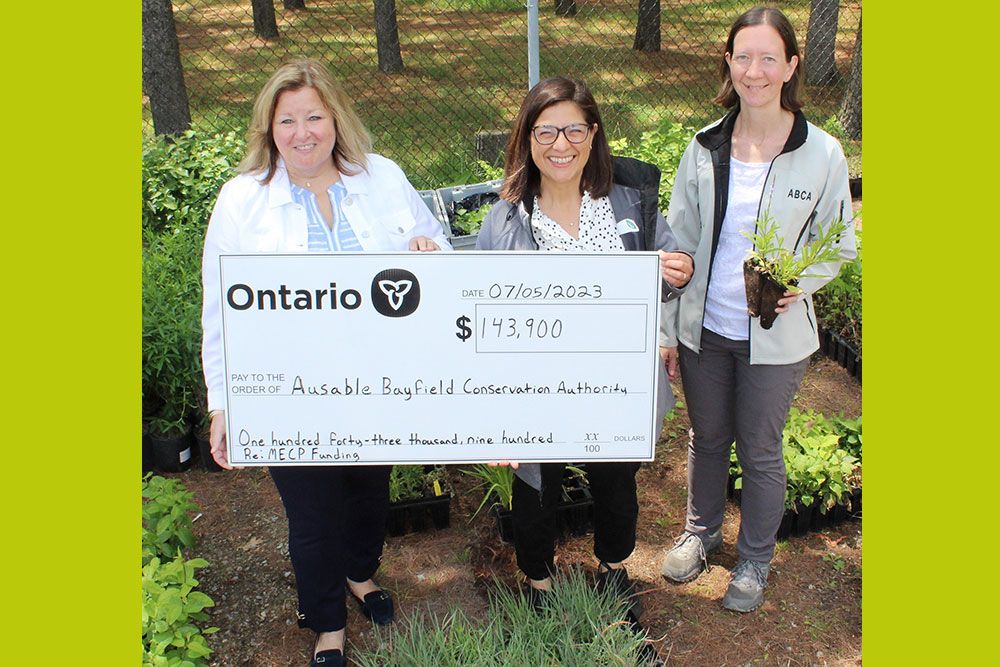Funding helps make 21 wetlands projects possible

Wetlands funding makes it possible for Ausable Bayfield Conservation to work with local landowners to enhance 21 wetlands
Wetlands are nature-based solutions that improve water quality and resiliency; work by participating local landowners responds to shortage of wetlands in area; funding from Province of Ontario helps make 21 local projects possible
Funding from the Province of Ontario, in 2023, is making it possible for Ausable Bayfield Conservation Authority (ABCA) to work with participating local landowners to enhance 21 needed wetlands. The funding is provided through the Ontario Ministry of the Environment, Conservation and Parks.
“Our government continues to invest in wetlands restoration through the Wetlands Conservation Partner Program,” said David Piccini, Minister of the Environment, Conservation and Parks. “Since 2020, we have supported 330 wetlands conservation projects, including 21 wetland sites that have been restored or enhanced in partnership with Ausable Bayfield Conservation Authority. It’s important projects like these that will help prevent flooding, improve water quality and build climate resiliency across Ontario.”
“Acting as a natural filter, wetlands are an important part of local conservation efforts,” said Lisa Thompson, MPP for Huron-Bruce. “By working with local landowners and expanding the presence of wetlands throughout our communities, we are laying the foundation for more resilient land and water management in the future.” The MPP visited Morrison Dam Conservation Area to present the funding, for $143,900, to ABCA, for the 21 wetland enhancement projects.
Angela Van Niekerk is Wetlands Specialist with the ABCA. She said more wetlands are needed in the area and this funding is essential to make it possible for landowners to increase wetland cover. “We are enhancing 21 different wetlands, with the help of this funding, in partnership with landowners who are taking part,” she said. “These wetland improvements add needed habitat. They also hold back water during storm events, help to better protect water quality, and help to keep water on the land during times of low water.” These nature-based solutions also help to reduce downstream flooding and erosion, she said.
Wetlands in Ontario are described as the ‘kidneys of the landscape.’ They absorb, store and filter water before it reaches nearby waterways. Wetlands provide ecological goods and services that have environmental, economic and social benefits.
When wetlands are restored and enhanced it’s possible to see some of the habitat improvements in the first two or three years, Angela said. “Landowners who add wetlands on their properties begin to see a greater diversity of species in just a few years,” she said. “They may see more frogs and different species of frogs, for instance.”
Wetlands are lands that are wet for all or some of the year. They support water-loving plants such as Cattails, Sedges, Rushes, Blue Flag Iris, Willows, and Dogwoods. Wetlands filter water and remove contaminants. Wetlands benefit water quality and also water quantity. Wetlands capture water when there’s too much water on the landscape during flooding and runoff and release water gradually when water is needed during times of low water and drought. Wetlands also capture carbon. Wetlands provide habitat for waterfowl and for more than 600 species of plants and animals. They are among the most diverse and productive ecosystems in the world.
To find out more about stormwater management improvements and wetlands, and projects you can do to enhance them, visit the Ausable Bayfield Conservation website and the wetlands web page.
Are there wet areas on your property? Contact Ausable Bayfield Conservation staff for a site visit.
To contact staff about technical expertise and grants which may be available to help you with your potential projects visit the staff contacts web page.
Learn more: